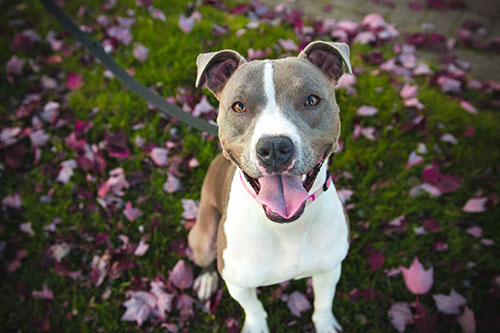6 SIGNS YOUR DOG IS HEALTHY
– Before placing your dog into a Training Program – Make Certain They’re in Great Physical Shape!

In addition to regular checkups with a family veterinarian, including routine wellness procedures such as an annual blood panel, fecal testing and urine analysis, these indicators should be noticeable to pet owners. Here are six signs your dog is healthy.
- Fresh Breath
A healthy mouth is the gateway to a healthy pet. Relatively clean-smelling breath and clean teeth absent of tartar buildup are signs of good health.
If your dog has gingivitis (also called gum disease) or periodontitis, it can ultimately affect vital organs and lead to serious health issues. Periodontitis is disease of the supporting structures of the teeth (bone, ligaments, etc.) and is the primary cause of tooth loss in pets. It’s caused by the buildup of food, plaque, and tartar in the spaces between the gum and the lower part of the tooth.
A rotten smell coming from your dog’s mouth could mean tooth decay or worse: oral melanoma, an aggressive form of cancer.
Routine dental care can result in improved overall health and longevity of a pet by spotting issues early on.
- Shiny, Clean Coat
Healthy pets will typically have a shiny, clean coat due to natural oils and shedding. A healthy pet doesn’t need to be bathed routinely unless your pet got dirty. Routine bathing for pets with fur (versus specific breeds with hair which require grooming) isn’t necessary and can lead to skin irritations.
If your dog is often licking, chewing or scratching, it could be a sign of a skin irritation, skin allergies, a bug bite or the presence of fleas. It’s also a sign your dog is uncomfortable; schedule a veterinary checkup to address the problem.
- Consistent Lean Weight

Pet obesity is a top health concern for veterinarians—excessive weight causes the same problems in dogs as it does in humans such as diabetes, heart and lung diseases, bone and joint diseases, skin conditions and different types of cancer.
If you notice your dog has dropped a noticeable amount of weight, a checkup is recommended as this could also be a sign of a health issue.
Your dog should have a consistent lean weight that doesn’t change much. You should be able to see your dog’s waist taper in toward the hips without the ribcage showing (this can vary based on breed). Pets need portion control as well when it comes to meals and treats. Discuss your dog’s ideal meal plan with your veterinarian to help maintain a healthy pet.
- Regular Bladder and Bowel Movements
How do you know if your dog has a tummy ache? Check out his poop. Healthy bowel movements will be absent of blood, mucus, worms, eggs, a chalky white discoloration, a black, tarry appearance, a greasy coating or diarrhea. If you notice a change it could be due to a change in diet, stress, allergies, parasites, bacterial infection, viral infection, ingestion of a toxic substance, pancreatitis, cancer, inflammatory bowel disease, colitis, or an obstruction.
The color of your dog’s urine is important: If your pet’s pee is the color of transparent yellow (straw yellow, pale gold, amber, clear yellow) it’s a sign of good health.
Dark or bright yellow could be a sign of dehydration. Orange is typically associated with jaundice or icterus, gallbladder problems, pancreatic problems, severe dehydration, liver disease or damaged blood cells.
If your dog’s urine is red, pink or cloudy it may be a sign of a urinary tract infection, cystitis, clotting diseases, trauma or cancer. If your dog is peeing inside the house or off a customary piddle pad, it could also be a sign of distress due to a health issue. A checkup is highly recommended for further testing.
- Alert, Engaged Interest

A healthy dog is eager to spend time with family, coming to you for playtime, watching and observing with interest.
If your dog suddenly starts spending time alone, is disengaged or sleeping more, it could be a sign of a health issue. Changes in behavior are one of the number one reasons pet owners discover something is off with their companions. Pay attention to any change and schedule an appointment with your veterinarian.
- Clean, Odor-Free Ears
Another sign of good health in dogs are clean ears: no waxy buildup, no discharge and no pungent or musky smell.
It’s normal for dogs’ ears to get dirty, so routine cleaning is recommended. Ignoring dirty ears can lead to pet ear infections — the second most common reason dogs visited vets in 2015, and a major source of irritation for our pets.
Clean ears also help maintain normal body temperature by radiating heat out.
One tell-tale sign your dog has an ear infection: smelly ears, sometimes like the smell of yeast. Schedule a checkup with your veterinarian if you suspect your dog is suffering from an ear infection. Common symptoms besides the smell and waxy buildup are side-to-side shaking of the head and pawing at the ear.
If you have questions about your dog’s health or are concerned that an issue may be present, contact your veterinarian immediately. Remember: You dog can’t always tell you when something is wrong. If you see a sign that has you questioning your pet’s health, don’t hesitate to schedule a checkup.




